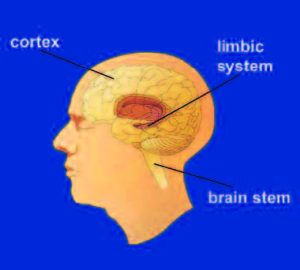4.3 The brain
Introducing the human brain
The human brain is the most complex organ in the body. This three-pound mass of gray and white matter sits at the center of all human activity—you need it to drive a car, to enjoy a meal, to breathe, to create an artistic masterpiece, and to enjoy everyday activities. In brief, the brain regulates your body’s basic functions; enables you to interpret and respond to everything you experience; and shapes your thoughts, emotions, and behavior.
The brain is made up of many parts that all work together as a team. Different parts of the brain are responsible for coordinating and performing specific functions. Substances can alter important brain areas that are necessary for life-sustaining functions and can drive addiction. Brain areas affected by addiction include:
- The brain stem, which controls basic functions critical to life, such as heart rate, breathing, and sleeping.
- The cerebral cortex, which is divided into areas that control specific functions. Different areas process information from our senses, enabling us to see, feel, hear, and taste. The front part of the cortex, the frontal cortex or forebrain, is the thinking center of the brain; it powers our ability to think, plan, solve problems, and make decisions.
- The limbic system, which contains the brain’s reward circuit. It links together a number of brain structures that control and regulate our ability to feel pleasure. Feeling pleasure motivates us to repeat behaviors that are critical to our existence. The limbic system is activated by healthy, life-sustaining activities such as eating and socializing—but it is also activated by use and misuse of substances. In addition, the limbic system is responsible for our perception of other emotions, both positive and negative, which explains the mood-altering properties of many substances.

How do the parts of the brain communicate?
The brain is a communications center consisting of billions of neurons, or nerve cells. Networks of neurons pass messages back and forth among different structures within the brain, the spinal cord, and nerves in the rest of the body (the peripheral nervous system). These nerve networks coordinate and regulate everything we feel, think, and do.
- Neuron to Neuron – Each nerve cell in the brain sends and receives messages in the form of electrical and chemical signals. Once a cell receives and processes a message, it sends it on to other neurons.
- Neurotransmitters—The brain’s chemical messengers – The messages are typically carried between neurons by chemicals called neurotransmitters.
- Receptors: The brain’s chemical receivers- “The neurotransmitter attaches to a specialized site on the receiving neuron called a receptor. A neurotransmitter and its receptor operate like a “key and lock,” an exquisitely specific mechanism that ensures that each receptor will forward the appropriate message only after interacting with the right kind of neurotransmitter.
- Transporters—The brain’s chemical recyclers – Located on the neuron that releases the neurotransmitter, transporters recycle these neurotransmitters (that is, bring them back into the neuron that released them), thereby shutting off the signal between neurons.

Chapter Credit
Adapted from Unit 2.3 in Drugs, Health & Behavior by Jacqueline Schwab.
Image Credits
- Diagrams from: National Institute on Drug Abuse. (2010). Drugs, Brain, and Behaviour: The Science of Addiction (pp. 15-16). http://preventiontrainingservices.com/resources/sciofaddiction.pdf

